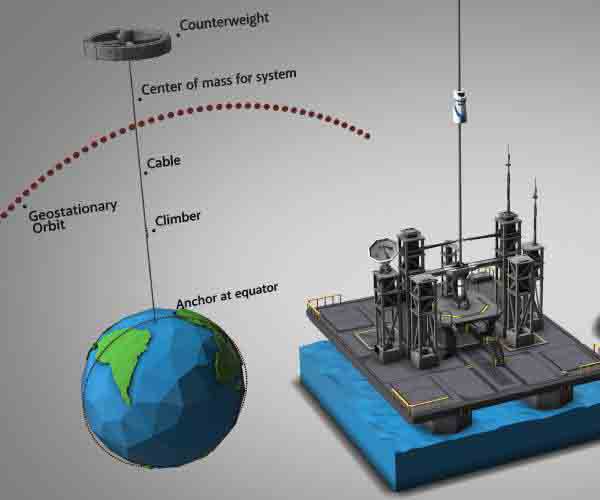Table of Contents
Even as Elon Musk’s SpaceX is achieving remarkable success in driving down the cost of space travel – in just a decade Musk has slashed the cost of getting a payload into orbit by 80% – new developments might make all his hard work redundant.
Enter the Space Elevator.
The idea of a space elevator has been around since at least 1979, and Arthur C. Clarke’s The Fountains of Paradise. Another giant of SF, Robert Heinlein, incorporated space elevators into his 1982 novel, Friday. More recently, Star Trek (2009) featured a swashbuckling fight on a space elevator.
Rather than merely fantastic imaginations, both Clarke and Heinlein came from a strong science and engineering background. There is nothing inherently wrong with the idea of connecting a geosynchronous orbiting platform to a point on the earth – the only problem is finding something strong enough to hold it together.
An unbelievably tough one is needed, for example, if mankind is to retire the archaic firecracker-like method of blasting payloads into orbit with chemical rockets.
Rockets have been around for nearly 800 years, but it’s only been in the last 63 years that they’ve been used to send stuff into space. Yet, even at the dawn of the Space Age, its pioneers were looking beyond the rocket.
Konstantin Tsiolkovsky, the great Russian rocketeer and devisor of the universal Tsiolkovsky Rocket Equation is the first to flirt with the idea of building tethers into space, 22,250 miles high, to hoist materiel and personnel into orbit cheaply, prosaically, by virtue of literally winching the cargos into orbit. The beauty of orbital stations at exactly this height — geosynchronous orbit — is that the floating space station or satellite at the destination level remains perpetually drifting over a fixed point on the surface of the Earth forever, seemingly set and unmoving.
A space elevator’s cables would be held taut by the rotational force of the Earth pitted against the pull of gravity, skimming the surface of the Earth yet stretching to orbital altitudes at geosynchronous levels. It would be as epoch-changing as anything ever constructed in human history.

If you’ve ever spun an object at the end of a string, you get the concept. The problem with scaling up to a space elevator is finding a piece of string tough enough. Some big money thinks they’re going to find it soon.
Physicists are exploring a gamut of esoteric materials that possess mind-boggling tensile strength in hopes of discovering a substance up to the job: carbon nanotubes, boron nitride nanotubes, diamond nanothreads, graphene, etc.
The Obayashi Corporation, the mega-construction company based in Tokyo, has declared that it will build a space elevator by 2050; the Chinese say theirs will be up and running by 2045.
So, what’s the big deal about a space elevator?
The benefits of a space elevator can’t be overstated.
It would convert trips to space from the rare and shockingly expensive to the realm of common and relatively cheap. Today it costs $3,500 per pound to hoist something into Earth orbit; that cost could plummet to around $25. And with enough goods and materiel in the near-future being shunted back and forth between the ground and space, manufacturing in orbit — where products impossible or very difficult to make on Earth can be created in micro-gravity — might really take off.
The next industrial powerhouse, the future Pittsburgh, Detroit or Manchester, may not even be on the surface of this planet, but far above it.
But Elon Musk’s SpaceX efforts will not necessarily be wasted.
A space elevator will also make interplanetary travel much cheaper – including asteroid mining – but they’ll still need rockets to get there, as well as to land and take off again.
Until they build a space elevator on Mars.
Please share this article so that others can discover The BFD









